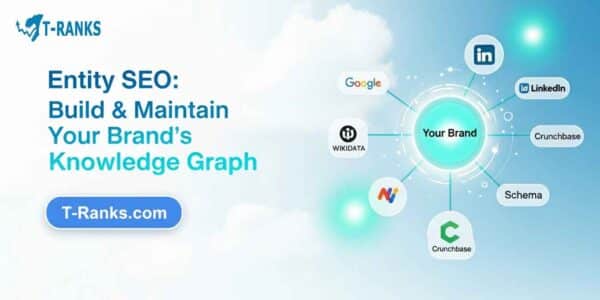Search has evolved. Google no longer ranks content just because it contains the right keywords.
Today, it prioritizes brands and entities it can clearly identify, verify, and trust.
That’s where Entity SEO comes in.
Instead of optimizing for strings of text, you optimize for real-world things people, organizations, products, and concepts that Google can confirm and connect through its Knowledge Graph.
Modern search engines like Google, Gemini, and Perplexity now rely on entities, not just keywords, to determine which brands deserve visibility and citations in AI Overviews.
When your brand is defined as a consistent, verifiable entity supported by external proof, it becomes easier for AI systems to trust, display, and credit your content.
In this guide, you’ll learn:
- What Entity SEO means and how it works
- Why it’s replacing traditional keyword-based optimization
- How to build and maintain a Knowledge Graph that strengthens your brand’s authority across Google and AI-powered search
What Is Entity SEO?
Before diving into Entity SEO, let’s first understand what an entity really is because this is where most people get confused.
What Is an Entity?
In Google’s world, an entity is a unique, well-defined, and verifiable thing that exists in reality. It isn’t just a word or phrase , it’s something specific and identifiable, like a person, brand, organization, product, place, or concept.
Think of it this way: The word “Apple” could mean a fruit, a technology company, or a music label. But Apple Inc. as an entity refers to one clear thing the tech company founded by Steve Jobs in Cupertino, California.
Key traits of an entity:
- Unique: Distinct from everything else
- Real: Exists physically or conceptually
- Identifiable: Has describable attributes (name, type, relationships)
- Verifiable: Confirmed through reliable, independent sources
Examples of real entities:
- Semrush – An SEO software company founded in 2008, headquartered in Boston.
- Neil Patel – A digital marketing expert with verifiable credentials, content, and citations.
- Eiffel Tower – A landmark in Paris built in 1889 with known dimensions and history.
Now compare these with vague phrases like “SEO tool” or “marketing expert.” Those are just keywords. Google can’t verify what they point to, so they remain ambiguous.
What Is Entity SEO?
Now that we’ve defined entities, here’s the clear definition:
Entity SEO means helping Google understand what your content is really about real people, brands, places, or things — instead of just matching a bunch of keywords.
In simple terms, Entity SEO helps Google recognize who you are, what you do, and how you connect to other known entities. It builds identity, not just rankings.
Why Entity SEO Is Different From Traditional Keyword SEO

Traditional SEO focused on keywords.
Entity SEO focuses on meaning helping Google understand exactly who or what your content represents, not just which words it contains.
When Google understands the entity behind your page, it no longer treats your content as one of many keyword matches. It sees it as a reliable, verifiable source connected to real-world data.
That’s why Entity SEO often performs better than traditional keyword tactics in visibility, rankings, and trust.
Traditional Keyword SEO
Keyword-based SEO tries to win by repetition.
For example, a company might target “email marketing software” and use that phrase several times across its content, hoping to appear higher in search results.
But Google doesn’t know whether the page is about HubSpot, Mailchimp, or just a general list of tools.
It can’t connect that content to a specific brand or product.
So the page ends up competing with many others using the same words, with little authority or recognition.
Entity SEO
Entity SEO takes a smarter approach.
Instead of focusing on keywords, it focuses on defining the entity behind the content.
Imagine you optimize around Mailchimp as a real company entity.
You add Organization schema, link to verified profiles on LinkedIn, Crunchbase, and Wikipedia, and mention related entities such as Intuit, HubSpot, and Constant Contact.
You also include author schema for verified contributors.
Now Google doesn’t just see the phrase “email marketing software.”
It recognizes your page as being about Mailchimp, the verified company with relationships, credibility, and external proof.
Because the entity is clear, your content is more likely to appear in Knowledge Panels, AI Overviews, and citation snippets.
It maintains stable rankings even when keyword trends change, building long-term trust instead of short-lived traffic.
Performance Difference in Action
| Approach | Example | How Google Interprets It | Outcome |
| Keyword SEO | Best email marketing tools 2025 | A list of pages competing for the same keyword | Temporary rankings, low authority |
| Entity SEO | Mailchimp: Email marketing software for small businesses | A verified company entity connected to real data sources | Knowledge Panel visibility, AI citations, brand trust |
Key Takeaway
Keyword SEO chases relevance. Entity SEO builds recognition.
When your brand is understood as a real entity, backed by structured data, consistent facts, and trusted external profiles, Google doesn’t just index your page. It remembers your brand.
That’s why modern SEO success depends on being recognized, not just being found.
How Google Uses Entities to Understand Content
When you search “Jaguar”, Google determines context by connecting related entities. It looks at whether your query mentions wildlife (the animal), automotive (the car brand), or sports (the NFL team). Your search history, location, and website structured data help Google disambiguate which “Jaguar” you mean.
Similarly, searching “Apple” vs “apple nutrition” triggers different entities: the company vs the fruit. Entity SEO gives Google those context clues so it can display the right results.
Core Principle of Entity SEO
Optimize for clarity, not just keywords. Make it impossible for Google to confuse what you represent.
Ask yourself:
- Who are we as an entity?
- How can we prove we’re real and trustworthy?
- What other entities are we connected to?
- Is our information consistent across the web?
When your answers are backed by structured data, verified profiles, and consistent facts, you move from “ranking for words” to being recognized as a trusted entity visible in Knowledge Panels, AI Overviews, and contextual search results.
How Google Understands, Verifies, and Uses Entities in Search

Google does not trust a name, brand, or subject just because it appears once.
It must first understand what the thing is, whether it is real, and how it connects to other known entities.
To do this, Google follows four predictable steps:
Discovery → Validation → Connection → Ranking
Now let’s break down each stage step by step.
1) Discovery & Indexing — When Google finds the entity for the first time
At this stage, Google is not evaluating trust it is only detecting existence.
Google scans your site and the wider web to see whether an entity is mentioned, defined, or marked up in a structured way. Anything that helps Google recognize the entity (even before trusting it) belongs to this phase.
How Google discovers entities:
- Schema markup — explicit JSON-LD declarations
- Named Entity Recognition (NER) — extracting names from page text
- Linked Open Data — Wikidata and Wikipedia supply machine-readable facts
- Public profiles — LinkedIn, Crunchbase, G2, Google Business, app stores
- Mentions and reviews — news, interviews, podcasts, industry directories
Discovery answers: “Does this entity exist?”
2) Validation — When Google checks if the entity is real and trustworthy
Once Google detects the entity, it must decide whether the information is reliable.
One page making a claim is not enough. Google compares facts across respected and independent sources. If the same details repeat without contradiction, confidence rises. If there are mismatches, confidence drops.
Google increases trust when:
- The same facts appear on multiple authoritative sources
- Names, dates, HQ, and founders match exactly everywhere
- Wikidata, LinkedIn, Crunchbase, and the website do not conflict
- The entity shows a real footprint (reviews, press, authors, business presence)
Rule of validation: One website = a claim. Multiple matching sources = a fact.
Validation answers: “Can I trust this entity?”
3) Connection — When Google links the entity to the rest of the web graph
Even if a brand is real and verified, Google still needs context:
Where does this entity belong? Who is it related to? What category is it part of?
This phase builds relationships between entities so Google can place them inside the knowledge graph.
Google builds connections using:
- sameAs links — to official profiles and knowledge sources
- Schema relationships — founder, worksFor, brand, parentOrganization
- Co-citations — appearing with other known entities in the same topic space
Example: “Shopify, Klaviyo, Omnisend…” in one article signals a shared category
- Relevant backlinks — from trusted, topically aligned pages
- Internal linking — connecting entity pages on your own site
Connection answers: “Where does this entity fit in the knowledge graph?”
Components of an Entity-First SEO Strategy
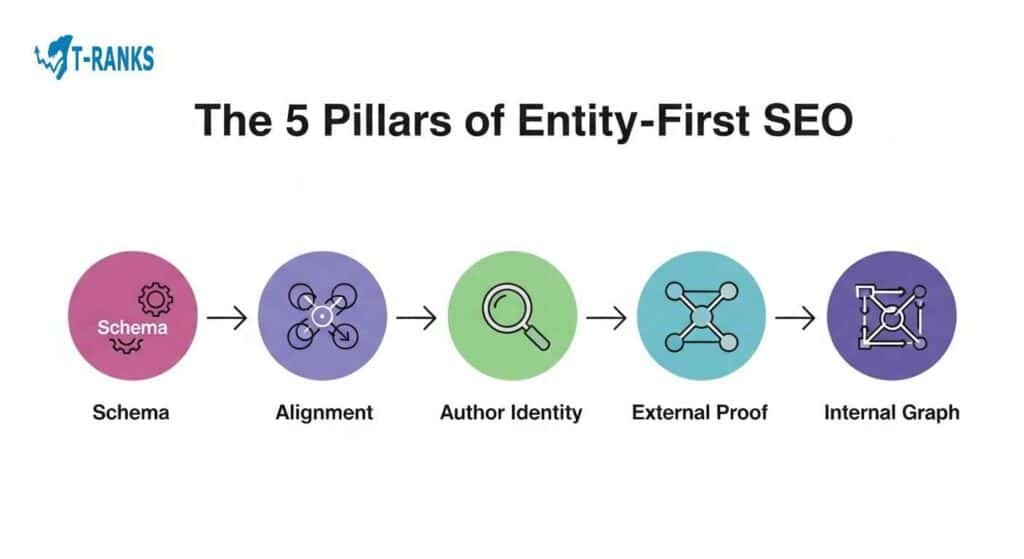
Entity SEO is not about pushing pages to rank. It is about helping Google understand who you are, what you offer, and how you fit into the web of other known entities. Once Google understands your identity clearly, rankings and AI citations come as a result not as the first goal.
An Entity-First strategy has five main parts:
Schema & Metadata → Entity Alignment → Author Identity → External Mentions → Content Graphing
Schema and Structured Data
Schema is how you speak to Google in its own language.
It is a structured layer of code that labels what your page contains so Google does not have to guess.
You can mark up things like:
Organization, Person, Product, CreativeWork, Event, FAQPage
You can also show connections using:
sameAs, worksFor, brand, knowsAbout
When this layer is correct and complete, your brand becomes eligible for rich results and AI visibility because the information is machine readable, not just human readable.
Entity Alignment and Consistency
Google does not trust a brand if its details appear differently in different places.
If your homepage says “T-Ranks”, LinkedIn says “T-Ranks SEO Agency”, and Crunchbase says something else Google treats them as separate identities.
To build trust, keep the same:
brand name, description, founding year, address, and leadership details everywhere website, schema, LinkedIn, Crunchbase, directories, profiles.
Consistency is not a cosmetic task. It is a trust signal.
Author and Contributor Identity
Google wants to see who is actually speaking.
Anonymous content is treated as low-trust.
To fix this:
– Add author names on all articles
– Create author pages with role, experience, and real profile links
– Use Person schema and connect authors to your organization using worksFor
When Google can verify the people behind the content, your credibility increases especially in sensitive topics.
External Mentions and Backlink Proof
Google does not believe a claim just because you wrote it on your own site.
It checks what other trusted sites say about you.
That is why external mentions matter more than self-statements.
A single link or even an unlinked mention from a credible industry source can help more than dozens of weak backlinks. Entity SEO is about validation, not volume.
Content Graphing and Internal Linking
Google understands your site better when your content is connected like a map, not a pile of articles.
Instead of linking just for keywords, link by meaning and relationships.
For example:
Create a main hub page for a topic. Then create supporting pages and link them back with clear descriptive anchors.
Do the same for product pages, author pages, and related entities.
This creates a visible knowledge structure inside your own site which Google can interpret and trust.
In short:
You are not just ranking pages you are building a verified identity that AI systems can understand, trust, and cite.
Building Your Brand’s Knowledge Graph
Before you can build one, you need to know what it is and why it matters.
What is a Knowledge Graph?
A knowledge graph is Google’s database of “facts about real things and how they are connected.”
Those “things” are entities like brands, founders, products, locations, services, and topics and Google stores verified information about them in a structured way.
In simple words:
A knowledge graph is Google’s internal profile of your brand and its relationships — not just your website.
Why is a Knowledge Graph important for businesses?
If your brand exists clearly inside Google’s Knowledge Graph:
- You are more likely to earn a Knowledge Panel (brand visibility boost)
- You are more likely to be cited in AI Overviews, ChatGPT, Gemini, and Perplexity
- Your brand is treated as a trusted source, not just another webpage
- Your rankings become more stable because trust is entity-based, not keyword-based
Brands with strong entity presence get authority “by default” because Google already knows who they are before reading their content.
Example
When someone searches “Netlify” — Google does not scan page by page.
It pulls from the Knowledge Graph — company name, category, founders, funding, product — and shows it instantly in a Knowledge Panel.
That same trust is what AI Overviews use when deciding who to quote.
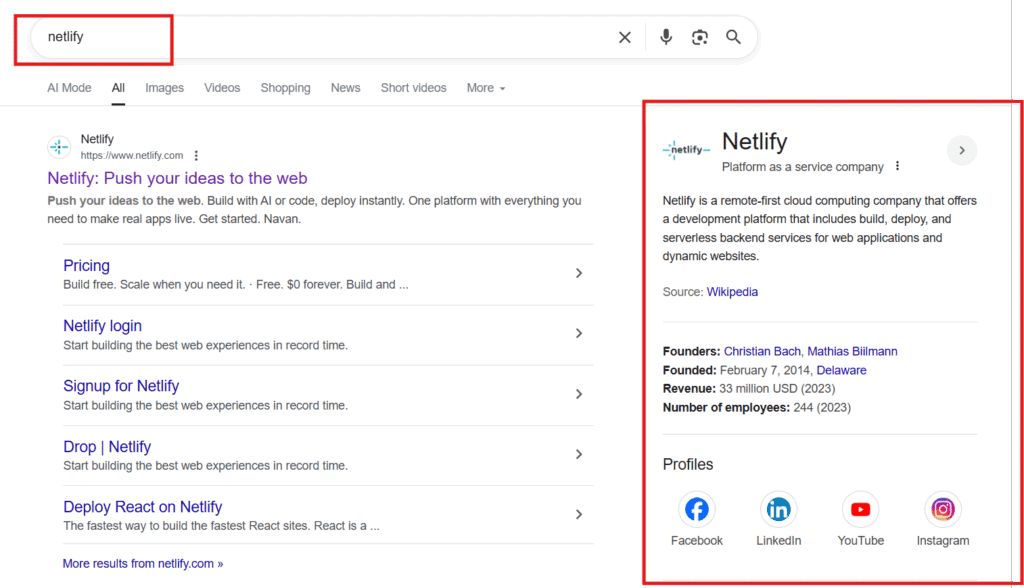
How to Build Your Brand’s Knowledge Graph (Step by Step)
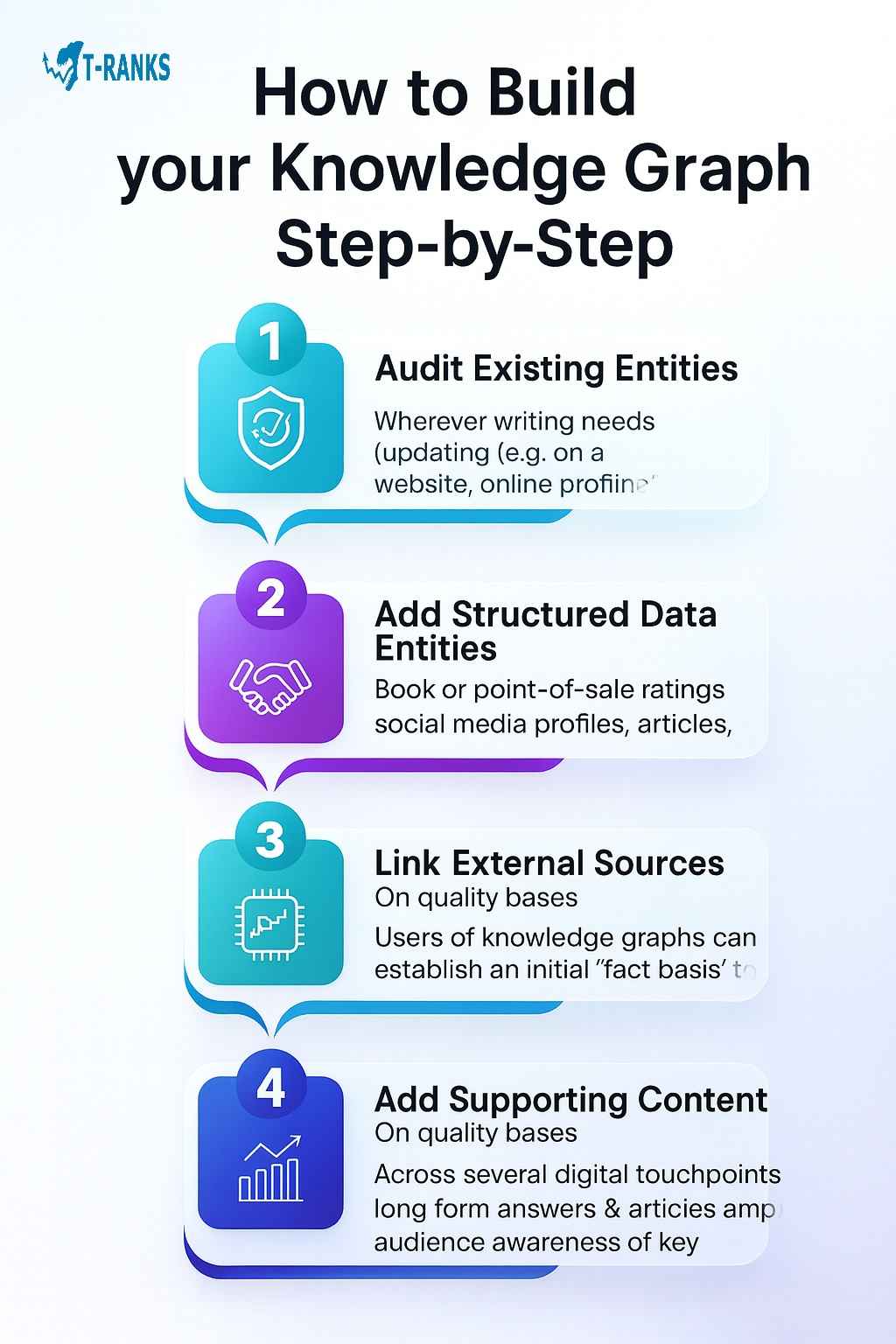
You don’t build it overnight it’s a gradual process that strengthens layer by layer.
Step 1 — Audit What Google Already Knows
Before improving your entity, first discover what already exists.
Search your brand, founders, and product names on Google.
Look for signs like a Knowledge Panel, People Also Search For, or structured snippets.
Use tools such as Kalicube Pro, Google Knowledge Graph API, or RankRanger Entity Tracker to confirm what Google already recognizes.
Goal: Create a list of entities Google connects to your brand — even if they’re incomplete or inconsistent.
Step 2 — Add or Standardize Structured Data
Now that you know what Google sees, make your data easy for it to read.
Add schema.org markup in JSON-LD format for all key pages:
- Organization – your company information
- Person – founders, authors, or experts
- Product / Service – what you offer
- Article / FAQ / CreativeWork – your content assets
Include essential properties like @id, sameAs, worksFor, brand, and knowsAbout.
This gives Google structured clues to connect your pages to real entities without relying on text guesses.
Step 3 — Align With Verified External Sources
Once your structure is ready, prove it with external validation.
Google verifies facts by comparing your information with trusted databases.
Ensure your name, logo, and descriptions match exactly on:
LinkedIn, Crunchbase, G2, Capterra, Wikidata, press mentions, and app stores.
When all these profiles show identical details as your schema, Google treats it as a single confirmed truth, not multiple uncertain versions.
Step 4 — Add Supporting Content Nodes
After structure and validation, reinforce your entity with proof and context.
Create content that supports and expands your entity profile:
- Topic clusters and FAQ pages that mention your brand naturally
- Case studies and whitepapers demonstrating expertise
- Founder interviews and podcast features
- Partnership pages, PR mentions, and event recaps
Each content piece should link back internally and reference related entities.
This helps Google and AI systems connect your brand within a wider context network essential for citations and AI Overview mentions.
Step 5 — Monitor and Maintain Your Entity
Your entity isn’t static — it evolves as your business grows.
Review your entity data quarterly using:
Google KG API, Kalicube Audit, Schema validators, and brand consistency checks.
When changes occur new CEO, updated logo, rebranding, or product launch update every platform simultaneously: website, schema, LinkedIn, Crunchbase, and Wikidata.
This keeps your entity consistent and prevents trust decay.
Final Thought
A brand without a Knowledge Graph is invisible to AI search.
A brand with a verified Knowledge Graph earns visibility, citations, and authority by design, not by luck.
This is how you future-proof your brand’s presence across Google, Perplexity,ChatGpt and AI Overviews by making your entity impossible to misunderstand.
How to Choose SEO Partners Using the PPR Model
Not every partnership helps your SEO. Some brands look big but bring zero value to authority or rankings.
The PPR model helps you choose partners that actually improve your visibility.
PPR stands for: Popularity — PageRank — Relevance
You should check all three before collaborating with anyone.
1) Popularity — Do people really see them?
Popularity shows if the brand already has a real, active audience.
If a partner is already visible, any co-content or co-mentions will reach more people.
Check things like:
- Do they have active followers on LinkedIn, YouTube, or email?
- Do people actually engage (comments, shares), or is it dead?
- Are they invited to podcasts, webinars, events, or mentioned in blogs?
Example
When Canva and HubSpot publish something together, it spreads fast because both already have big audiences.
Tools to check: SimilarWeb, LinkedIn analytics, BuzzSumo
2) PageRank — Can they pass SEO strength to you?
A partner can be popular but still weak in SEO.
You want partners whose websites have strong trust and clean backlink profiles.
Check things like:
- Domain Rating (DR 60+ in Ahrefs or Moz is a strong signal)
- Links are dofollow, not “nofollow”
- Links are placed inside real content, not hidden in footers or logos
Example
One link from a HubSpot integration page is stronger than 10 links from random blogs.
Tools to check: Ahrefs, Moz, Majestic
3) Relevance — Do you serve the same type of users?
This is the most important filter.
A partner is useless if their audience will never need or consider your product.
Ask yourself:
- Do both brands serve the same kind of users?
- Would people logically use both tools together?
- Do both brands publish content on related topics?
Example
Notion and Slack serve the same audience (teams and startups).
Their integration makes sense it is useful to users and natural to Google.
Tools to check: Ahrefs (Content Gap), G2 Categories, App directories
Simple rule to remember
A partnership is only valuable if it checks all three:
Popular + Authoritative + Relevant = Real SEO value
If even one is missing, the partnership may help with branding
but it will not help with rankings, entity strength, or AI citations.
Entity SEO for AI Overviews (AEO)
Search engines and AI systems like Google’s AI Overviews, ChatGPT, and Gemini don’t read the web the way humans do.
They don’t interpret long paragraphs or opinions — instead, they extract short, verified facts from trusted, clearly defined entities.
When your brand is recognized as a stable entity, AI can confidently quote you.
If not, your ideas might still be used but the credit will go to someone else.
Entity SEO solves that problem. It helps search engines and AI models recognize your brand as safe to cite, just like Wikipedia, Wikidata, or LinkedIn.
How AI Decides What to Cite
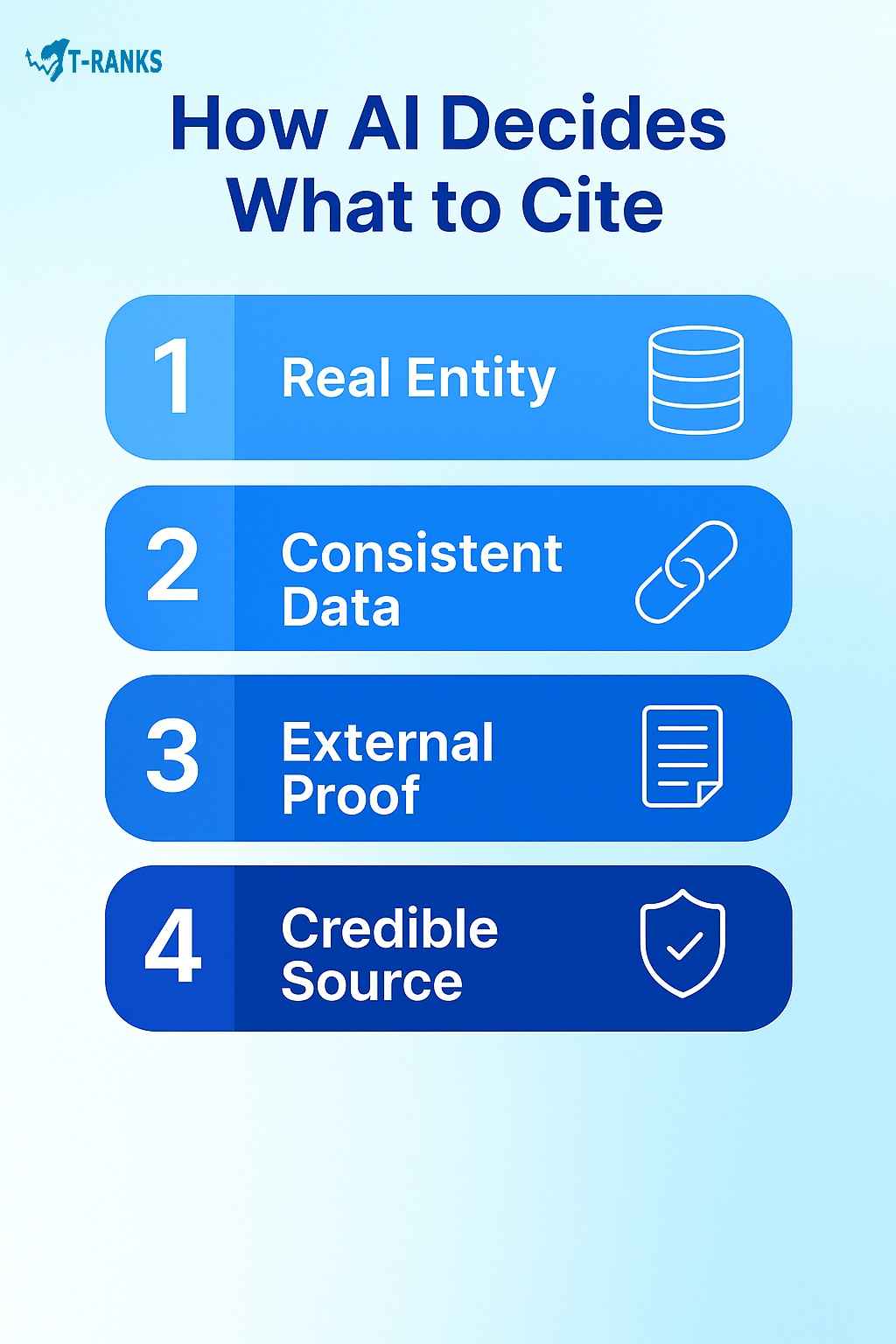
Before an AI model includes a brand or page in its answer, it silently asks a few questions:
- Is this a real and verified entity?
- Are its facts consistent across the web?
- Is it credible and connected to other sources?
- Can its claims be verified externally?
If all of these boxes are checked, your content has a much higher chance of appearing inside AI Overviews with attribution.
How Entity SEO Boosts Your AI Citation Chances
If you want AI systems like Google’s Overviews or ChatGPT to mention your brand by name, you first need to help them recognize who you are. Let’s see how Entity SEO makes that possible.
1. Define Your Entity in a Machine-Friendly Format
First, make sure search engines can easily read what your brand represents.
Add schema markup to the right pages Organization, Person, Product, and Article.
Give each entity a unique ID, link your profiles with sameAs properties (LinkedIn, Crunchbase, Wikidata, G2, App Stores), and keep your name, logo, and description identical everywhere.
These steps turn your brand into structured data that AI can instantly recognize and trust.
2. Attach Real Authors to Your Content
AI systems favor content written by verified humans, not anonymous pages.
Always include author bylines and create author pages showing credentials and linked profiles.
Use Person schema with worksFor to connect your authors back to your brand.
This human layer increases trust and improves your chances of being cited.
3. Back Your Claims with Real Evidence
AI doesn’t guess — it checks for proof.
Support your statements with numbers, dates, research links, and reviews.
Avoid vague claims like “we’re the best” or “industry-leading”.
Instead, show data and external validation that make your content verifiable.
4. Format Content for Easy Extraction
AI prefers structured, scannable information.
Help it by:
- Starting each page with a short TL;DR summary.
- Using short paragraphs and one clear idea per sentence.
- Writing question-based headings.
AI systems don’t interpret — they lift text blocks that match their query exactly.
So clarity and formatting are key.
From Being Used → To Being Credited (Attribution Optimization)
Being used by AI isn’t enough — you want to be named as the source.
To make attribution happen:
- Mention your brand name naturally in the first answer block.
- Repeat your entity name near the top so AI can’t detach it from the quote.
- Include related entities (like Shopify, Stripe, Zapier) to strengthen topical context.
- Use Article schema with both author and publisher defined.
- Keep your facts on focused URLs, not buried on homepages.
- Add internal links using descriptive anchor text with entity names.
- Create 40–80 word “answer nuggets” that AI can lift as-is.
Example of an AI-ready answer nugget:
Omnisend integrates with Shopify and syncs customer and order data in real time. It sends cart recovery and welcome flows without manual setup. G2 shows a rating above 4.5 from thousands of verified reviews.
Short, factual, and verifiable — that’s exactly what AI looks for.
Keeping Your AI Visibility Permanent
Earning an AI citation once is great — but maintaining it matters even more.
AI systems stop citing brands when data becomes outdated or inconsistent.
Here’s how to stay credible:
- Maintain a public changelog for brand details and products.
- Update LinkedIn, Crunchbase, and schema at the same time.
- Monitor entity recognition using Kalicube or Google’s Knowledge Graph API.
- Correct misinformation publicly when found.
- Keep a Facts Page on your site with official data and references.
- Track how often AI tools cite your brand and refresh weak or outdated pages.
1️⃣ Trust your information.
2️⃣ Select your content as a reliable source.
3️⃣ Credit your brand by name inside the answer.
That’s how Entity SEO transforms your brand from simply being indexed to being recognized, trusted, and cited inside AI Overviews.
Maintaining Entity Health for AI Overviews and LLM Citations
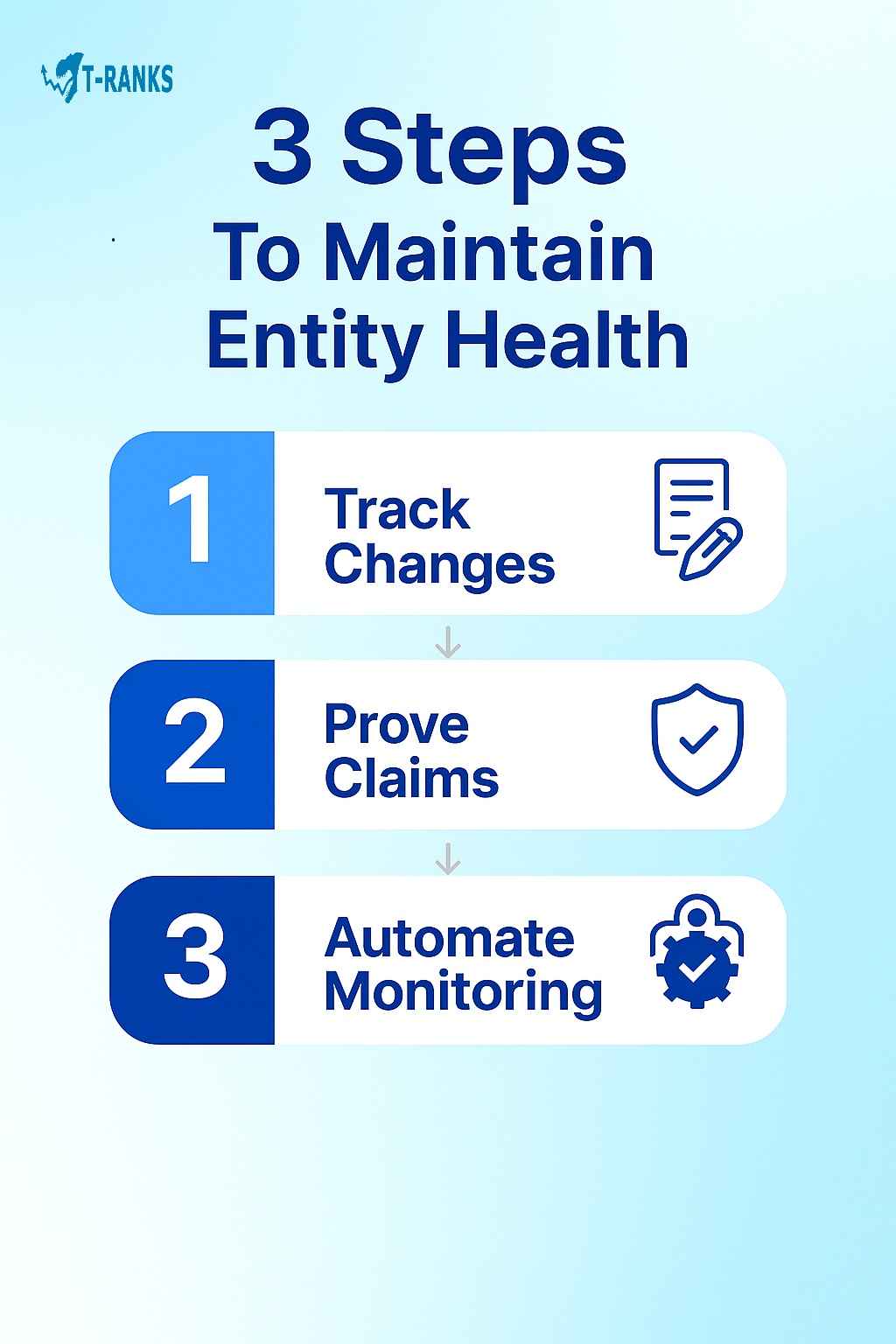
Getting cited in AI Overviews, ChatGPT, or Perplexity is not a one-time achievement.
Your entity must stay accurate, consistent, and verifiable over time.
If your information drifts even slightly, AI systems lose confidence and stop citing you.
1) Track Changes to Prevent Entity Drift
Your business changes new CEO, new product, new address, new tagline.
If these changes are not updated everywhere, AI detects conflict and stops trusting you.
Keep a simple change record for:
- Brand name, tagline, or logo changes
- Leadership or team updates
- New or discontinued products
- Schema updates on key pages
- Business data like address, founding year, or stats
Why this matters
If your site says one thing, LinkedIn says another, and Crunchbase says something else — AI assumes the data is unreliable and excludes you.
2) Prove Every Claim with a Trusted Source
AI does not repeat claims unless it can confirm them somewhere else.
It prefers facts that come from credible and traceable sources.
Strengthen your evidence by:
- Citing Wikipedia, Wikidata, Crunchbase, or official documents
- Linking to reviews, press, or app store listings
- Showing author credentials with Person schema
- Using exact numbers, names, and dates — not vague marketing claims
- Displaying “last updated” dates on key pages
Why this matters
If AI can verify a fact in seconds, it cites you. If it cannot, it ignores you and cites another brand.
3) Automate Monitoring So You Don’t Lose Visibility
Manual checks are slow and easy to forget.
Automation prevents silent entity decay.
Automate tasks like:
- Checking schema validity and errors
- Tracking entity mentions across the web
- Watching for Knowledge Panel or Wikidata changes
- Auditing internal links for entity pages
- Getting alerts for mismatched names, dates, or bios
Why this matters
AI trust is fragile. A single outdated field or broken signal can remove your brand from AI Overviews overnight.
Automation catches problems before AI does.
Result
Maintaining entity health keeps your brand eligible for AI Overviews, LLM answers, and trusted citations long after the initial setup.
Without ongoing governance, entity trust decays in the background — and AI visibility disappears without warning.
Common Entity SEO Mistakes (And How to Fix Them)
Most brands don’t lose AI visibility because they ignore entity SEO ,they lose it because the signals they send are weak, incomplete, or conflicting.
Google and AI systems only trust entities that are consistent, verifiable, and supported by external proof.
These are the most common reasons brands fail to appear in AI Overviews, Knowledge Panels, and LLM answers — and how to fix each one.
1) Schema Added Only on a Few Pages (Instead of Site-Wide)
Problem: Schema exists only on the homepage or one template, with no links between entities.
Fix: Add Organization, Person, Product, and Article schema across all relevant pages and connect them using @id, worksFor, brand, publisher, etc.
2) Missing sameAs Links to Verified External Profiles
Problem: Google sees only your own website claim — no confirmation elsewhere.
Fix: Add sameAs links to LinkedIn, Crunchbase, Wikidata, app stores, G2, or PR features so Google can verify your entity externally.
3) Marketing Claims Without Proof or Sources
Problem: Pages say “industry leading” or “trusted by thousands” with no numbers or citations.
Fix: Replace claims with evidence — reviews, app ratings, partner docs, press links, or exact numbers AI can verify.
4) Conflicting Information Across Platforms
Problem: Your website, LinkedIn, Crunchbase, and schema show different names, dates, or leadership.
Fix: Standardize brand name, founding year, HQ, team, and descriptions everywhere before publishing new content.
5) No Real Author Identity Behind Content
Problem: Articles have no byline or anonymous “team” author.
Fix: Add named authors with Person schema and link them to LinkedIn, Healthgrades, Wikipedia, or other verified profiles.
6) Weak or Irrelevant External Mentions
Problem: Most mentions come from low-quality blogs or irrelevant niches.
Fix: Prioritize citations from authoritative, topical, and industry-aligned sources — even unlinked mentions count if they are credible.
7) No Internal Content Graph (Isolated Pages)
Problem: Pages exist in isolation with weak internal linking and no topic structure.
Fix: Build hub + spoke clusters around main entities and interlink pages using clear descriptive anchors.
8) Treating Entity SEO as a One-Time Setup
Problem: Schema is added once and never updated when facts change.
Fix: Maintain an entity change log and update schema, bios, and profiles in sync across all platforms to prevent drift.
Conclusion
In conclusion, entity SEO is now the base of online visibility. Search engines and AI tools do not rely only on keywords anymore. They trust brands that are clearly defined, easy to verify, and consistently represented across the web.
When your brand identity is stable, structured, and supported by outside proof, Google and AI systems can understand it, trust it, and show it more often. This leads to Knowledge Panels, rich results, AI citations, and long term authority.
Entity SEO is not a one time task. It works in a simple cycle. First you define the entity. Then you structure it using a schema. Then you connect it with trusted external sources. Then you maintain it over time so it does not drift or break. Brands that do this early gain a strong advantage. Brands that wait will compete from behind.
FAQs Of Entity SEO
How do I know if Google recognizes my brand as an entity?
You can check entity recognition using the Google Knowledge Graph API or Kalicube Pro. If your brand returns a Knowledge Graph ID or shows a structured card in search, it is recognized. If not, you must improve schema consistency, external mentions, and authoritative profiles.
What is the difference between an entity and a topic?
A topic is a general subject, but an entity is a specific identifiable thing like a brand, person, or product with a knowledge graph record. Entities help Google connect topics contextually to produce richer and more confident results.
Can small businesses benefit from entity SEO?
Yes, entity SEO works even without a Wikipedia page or large audience. Small businesses can build entity recognition through aligned schema, consistent business profiles, and mentions from local, niche, or industry trusted sources.
Does entity SEO replace backlinks?
No, backlinks are still important but they now act as part of an entity graph rather than a stand-alone signal. Links carry more weight when they connect verified entities inside a topical cluster instead of existing without context.
How does entity SEO affect AI Overviews?
Entity SEO increases the chance of being cited in AI Overviews because AI tools prefer verified entities over generic pages. When your brand has consistent schema and external corroboration, AI models are more likely to pull and credit your answers.
How can I fix conflicting entity data online?
Run a reconciliation pass and locate mismatched data such as names, dates, bios, or logos. Update all platforms at the same time and republish structured data so Google and AI systems recrawl a single, unified version of truth.
